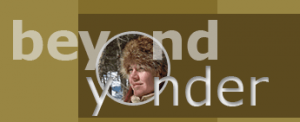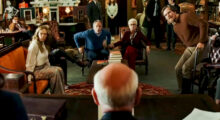Today, SevenPonds speaks with Cassandra Yonder, a Nova Scotia based homesteader with a passion for death midwifery. Yonder is dedicated to bringing death midwifery back into the home domain as a positive, accessible end-of-life option. In her own words, *“[a] death midwife works with people who are actively dying like a hospice volunteer might.” With an acute knowledge of both death midwifery and the funeral home industry, Yonder hopes to help others understand that they can transform the dying process back into a natural, do-it-yourself experience.
*This is the definition of a death midwife in the UK. In the US the title is sometimes used interchangeably with “home funeral guide”, and in Canada it is used in a broader sense to describe practitioners who support various aspects of end of life and post death care.
MaryFrances: How would you define death midwifery? Is it much different from being a home funeral guide?
Cassandra: Well, there’s the distance between death midwifery and home funeral guide; the first being a philosophical leader for a lot of practices that come up with end-of-life and post-death care. I’ve met all kinds of – shamans and spiritual – based guides. The terminology can differ.
My interests [as a grief counselor], of course, tend much more towards post-death. People will call [me] for help [after someone passes] and I’ll say, “look, I’m here for you, but you don’t really need me. I’ll help, but you don’t need me. Not legally.”
MaryFrances: How did you become involved in death midwifery? Do you have a personal story you’d like to share on the subject?
I moved to Nova Scotia to start a grief counseling practice and in the midst of getting that going, my friend and homesteading neighbor, Jeremy, died. He’d been having heart problems, but I didn’t anticipate he was near death. It was a winter day when he died, and I got the call from a neighbor, letting me know. It was imperative for me that I be there. I was surprised to find Jeremy’s body still there at home with his wife, Sue, on the floor of his bedroom. It was pretty magical. Everyone who was there wanted to get Sue away from Jeremy’s body [and] I know this was out of compassion, but I realized then that we try to put death out of site and out of mind. I think we comfort ourselves by trying to facilitate this alienation.
“Everyone who was there wanted to get Sue away from Jeremy’s body [and] I know this was out of compassion, but I realized then that we try to put death out of site and out of mind. I think we comfort ourselves by trying to facilitate this alienation”
What was happening between Sue and Jeremy was amazing to witness. We were just trying to know what to do, so we stayed there with him and she cuddled him up on the floor with their wedding quilt her mother made and their dogs and she just talked with him. All I said was, “In this moment, all we know is this is the last chance you have to be with his body,” and she took a lock of his hair. It took five hours for the transport service to come and get him – and that ended up being the right amount of time for her. She felt ready.
And then we wondered about a funeral. Jeremy was a wonderful homesteader, poet and musician who wouldn’t have wanted anything done by professionals that could be done by a community. So I spent three days on the phone, with a million different people — then things just fell into place. It was hard, but it was a type of hardness that showcased why home funerals are important.
Cassandra’s Three Insights into the Subject of Death:
1) It’s crazy to me to see humans get so riled up about demonizing bullfighters and trophy hunters, for example, but then go drive their SUV to the grocery store to buy a piece of meat wrapped in plastic that was raised in the most horrific conditions. By putting death out of site and mind we have become culturally alienated from natural processes.
2) We need an awakening; a moment of realization that “harming none” is not a possibility. To live, we must claim other lives—vegetable or animal. And that’s not something makes us guilty, it is what makes us alive, and death is part of that.
3) Understand “death denial.” Denial is a part of grief; it serves us in death acceptance. It’s not about being “cool with death” and that’s just missing the point—I would call that death denial! Really accepting death means accepting how painful and ugly it can be as well as how joyous or beautiful. Its about accepting those aspects of our relational bonds that end with death as well as those that continue on.
We gathered up a team of friends and relatives; one called me and said, “Hi. You don’t know me, but I have a van and am wondering if you need someone to go pick up his body in Halifax.” No one had ever come to pick up a body and put it into a homemade casket like that; and they were so accommodating at the morgue. We ended up having a home vigil and burial.
[Afterwards], I went to Final Passages in California to become certified as a home funeral guide. That event opened me [up] to something I hadn’t considered: death midwifery. The experience [of death midwifery] felt like attending a birth—the intensity, beauty and importance of it.
“The experience [of death midwifery] felt like attending a birth—the intensity, beauty and importance of it”
The home funeral movement sometimes strikes people as new age-y even though it’s simply the way things used to be. The general public isn’t that receptive yet since we have become used to the services offered by the funeral industry. But Baby Boomers are considering their choices in death care now. Many want affordable, environmentally friendly and hands on care by the family. Often, what I’ve been asked for is education — a lot of public speaking and teaching. In terms of clients, I do offer to help people. But mostly it’s people calling and asking questions about whether they can really do things like paperwork and body transportation themselves. It’s about slowly building awareness.
MaryFrances: What has your relationship with death been like?
My father is a veterinarian. I lived at his veterinary clinic as a small child. I played with the animals and saw many that were sick and dying. Also, I was conceived around the same time that my mother’s mother died. So my mom was grieving during the time I was in her womb and I think that has a lot to do with why I’m comfortable with grief. It’s not that I enjoy it, but it feels familiar and comfortable.
On a practical level, I sort of had one of those moments where I left one path entirely for a new direction. I wanted to reconnect with animals and nature, so I became a homesteader. I also went back to school to study Death and Dying at University of West Ontario in King’s College, [specifically] in Grief and Bereavement. But I think homesteading provides a really relevant venue for everything from birthing our babies, to making our own food and then caring for our dead. The animals that live with us and are [consumed by us] are appreciated; my kids don’t need have to have the big talk about death, because it’s happening at our homestead regularly as a natural part of life.
MaryFrances: Thanks for talking with us today, Cassandra.
Cassandra: Thank you.
Related Links:
- Visit Cassandra’s site
- Learn more about death midwife training
- What is an End of Life Doula? A SevenPonds Interview with Amy Levine

 What is Death Midwifery? An Interview with Cassandra Yonder
What is Death Midwifery? An Interview with Cassandra Yonder




 Having an Estate Plan Is Essential – So Is Discussing It With Your Children
Having an Estate Plan Is Essential – So Is Discussing It With Your Children

 “Summons” by Aurora Levins Morales
“Summons” by Aurora Levins Morales














